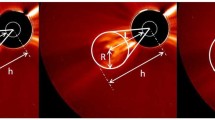Abstract
With the approaching of the 24th solar cycle peak year (2012–2014), the impacts of super solar storms on the geospace environment have drawn attentions. Based on the geomagnetic field observations during Carrington event in 1859, we estimate the interplanetary solar wind conditions at that time, and investigate the response of the magnetosphere-ionosphere system to this extreme solar wind conditions using global 3D MHD simulations. The main findings include: 1) The day-side magnetopause and bow shock are compressed to 4.3 and 6.0 Re (Earth radius), and their flanks are also strongly compressed. The magnetopause shifts inside the geosynchronous orbit, exposing geosynchronous satellites in the solar wind in the magnetosheath. 2) During the storm, the region-1 current increases by about 60 times, and the cross polar potential drop increases by about 80 times; the reconnection voltage is about 5 to 6 times larger than the average storms, which means a larger amount of the solar wind energy enters the magnetosphere, resulting in strong space weather phenomena.
Similar content being viewed by others
References
Cliver E W, Svalgaard L. The 1859 solar-terrestrial disturbance and the current limits of extreme space weather activity. Solar Phys, 2004, 224: 407–422
Clauer C R, Siscoe G. The great historical geomagnetic storm of 1859: A modern look. Adv Space Res, 2006, 38: 117–118
Green J L, Boardsen S. Duration and extent of the great auroral storm of 1859. Adv Space Res, 2006, 38: 130–135
Odenwald S, Green J, Taylor W. Forecasting the impact of an 1859-calibre superstorm on satellite resources. Adv Space Res, 2006, 38: 280–297
Shue J H, Chao J K, Fu H C, et al. A new functional form to study the solar wind control of magnetopause size and location. J Geophys Res, 1997, 102: 9497–9511
Lin R L, Zhang X X, Liu S Q, et al. A three-dimensional asymmetric magnetopause model. J Geophys Res, 2010, 115, doi: 10.1029/ 2009JA014235
Shue J H, Song P, Russell C T, et al. Magnetopause location under extreme solar wind conditions. J Geophys Res, 1998, 103: 17691–17700
Guo X C, Wang C, Hu Y Q, et al. Bow shock contributions to region 1 field-aligned current: A new result from global MHD simulations. Geophys Res Lett, 2008, 35: L03108, doi: 10.1029/2007GL032713
Ridley A J, De Zeeuw D L, Manchester W B, et al. The magnetospheric and ionospheric response to a very strong interplanetary shock and coronal mass ejection. Adv Space Res, 2006, 38: 263–272
Powell K, Roe P, Linde T, et al. A solution-adaptive upwind scheme for ideal magnetohydrodynamics. J Comput Phys, 1999, 154: 284–309
Tsurutani B T, Gonzalez W D, Lakhina G S. The extreme magnetic storm of September 1–2, 1859. J Geophys Res, 2003, doi: 10.1029/2002JA009504
Li X L, Temerin M, Tsurutani B T, et al. Modeling of 1–2 September 1859 super magnetic storm. Adv Space Res, 2006, 38: 273–279
Temerin M, Li X. A new model for the prediction of Dst on the basis of the solar wind. J Geophys Res, 2002, 107: 1472
Wang C, Li H, Richardson J D, et al. Interplanetary shock characteristics and associated geosynchronous magnetic field variations deduced from sudden impulses observed on the ground. J Geophys Res, 2010, 115, doi: 10.1029/2009JA014833
Hu Y Q, Guo X C, Wang C. On the ionospheric and reconnection potentials of the earth: Results from global MHD simulations. J Geophys Res, 2007, 112, doi: 10.1029/2006JA012145
Li H, Wang C, Kan J R. Mid-day magnetopause shifts earthward of geosynchronous orbit during geomagnetic superstorms with Dst <−300 nT. J Geophys Res, 2010, 115: A08230, doi: 10.1029/2009JA014612
Liou K, Wu C C, Lepping R P, et al. Midday sub-auroral patches (MSPs) associated with interplanetary shocks. Geophys Res Lett, 2002, 29: 16–20
Fedder J A, Lyon J G, Slinker S P, et al. Topological structure of the magnetotail as a function of interplanetary magnetic field direction. J Geophys Res, 1995, 100: 3613
Siscoe G L, Erickson G M, Sonnerup B U O, et al. Hill model of transpolar potential saturation: Comparisons with MHD simulations. J Geophys Res, 2002, 107, doi: 10.1029/2001JA000109
Hill T W, Dessler A J, Wolf R A. Mercury and Mars: The role of ionospheric conductivity in the acceleration of magnetospheric particles. Geophys Res Lett, 1976, 3: 429–432
Hill T W. Magnetic coupling between solar wind and magnetosphere: Regulated by ionospheric conductance? Eos Trans AGU, 1984, 65: 1047
Author information
Authors and Affiliations
Corresponding author
Rights and permissions
About this article
Cite this article
Wang, C., Li, H., Guo, X. et al. Numerical study on the response of the Earth’s magnetosphere-ionosphere system to a super solar storm. Sci. China Earth Sci. 55, 1037–1042 (2012). https://doi.org/10.1007/s11430-012-4405-4
Received:
Accepted:
Published:
Issue Date:
DOI: https://doi.org/10.1007/s11430-012-4405-4




